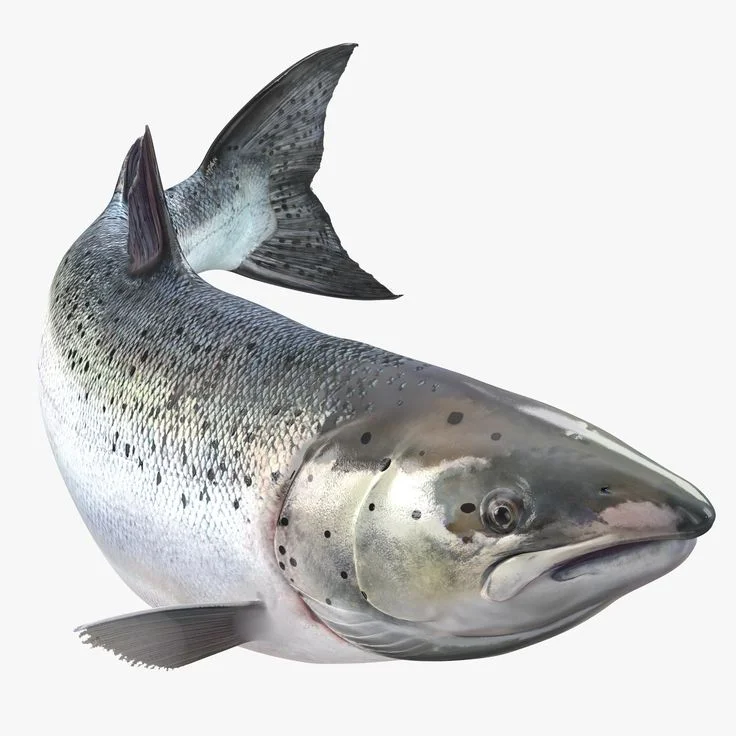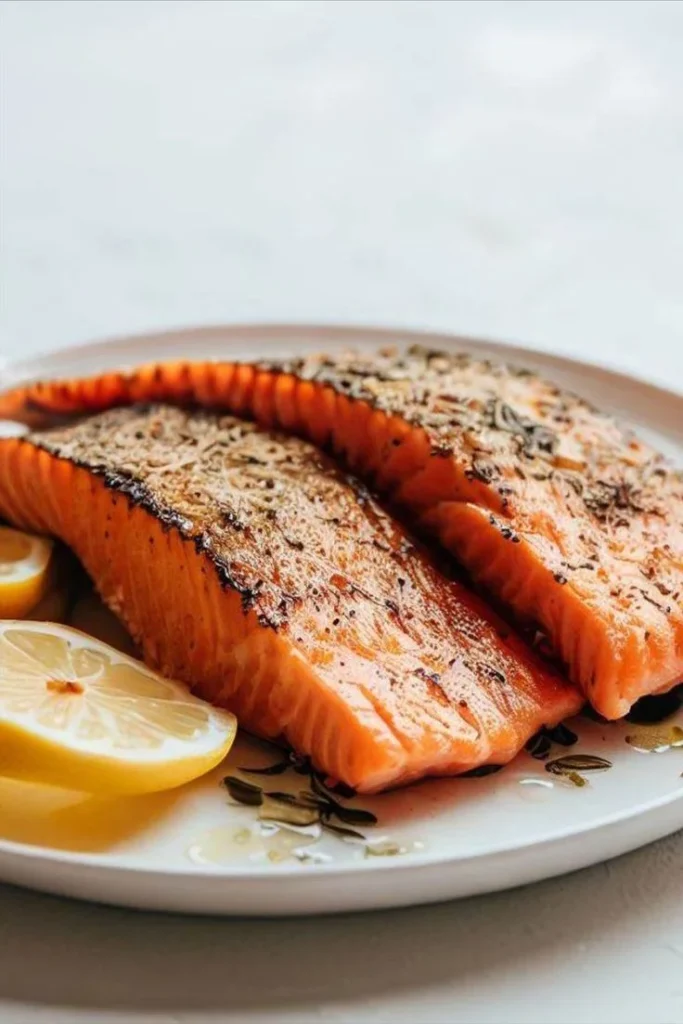Not sure whether to choose salmon or tilapia for dinner? Learn about the health benefits of each to make an informed choice.
Seafood is often touted as a healthy protein option, but when it comes to choosing between salmon and tilapia, which one should you go for? Both are popular choices, but do they offer the same health benefits? Let’s explore the nutritional differences between salmon and tilapia to help you make an informed decision about which fish is better for you.
What is salmon?

In the Northern Hemisphere, salmon are a type of fish that are native to both freshwater and saltwater environments. It is a well-liked eating fish with a unique flavor and pink flesh.
Since salmon move to the ocean to grow, they are anadromous, meaning they are born in freshwater and return to it to breed. Their high level of omega-3 fatty acids is highly valued since it is thought to offer numerous health advantages. Salmon can be cooked in several ways, such as baking, grilling, smoking, or even serving raw like sashimi or sushi.
Benefits of eating salmon
High in Omega-3 Fatty Acids: Salmon is one of the best sources of omega-3 fatty acids, particularly EPA (eicosapentaenoic acid) and DHA (docosahexaenoic acid). These fatty acids are essential for brain health, reducing inflammation, and supporting heart health.
Rich in Protein: Salmon is a high-quality source of protein, which is important for muscle repair and growth, as well as overall body function.
Heart Health: The omega-3 fatty acids found in salmon have been linked to various cardiovascular benefits, including reducing the risk of heart disease, lowering blood pressure, and improving cholesterol levels.
Brain Health: The omega-3 fatty acids in salmon are crucial for brain function and development. Regular consumption may help protect against cognitive decline and improve mood and mental well-being.
Eye Health: The omega-3 fatty acids in salmon are also beneficial for eye health, particularly in reducing the risk of age-related macular degeneration (AMD) and dry eye syndrome.
Anti-Inflammatory Properties: Salmon contains bioactive peptides that may have anti-inflammatory effects, which can help reduce inflammation in the body and lower the risk of chronic diseases.
Nutrient Density: Salmon is rich in essential vitamins and minerals, including vitamin D, vitamin B12, selenium, potassium, and others, which are important for overall health and well-being.
Weight Management: The high protein content of salmon can help promote feelings of fullness and satiety, which may aid in weight management and weight loss.
What is tilapia?

Tilapia is a freshwater fish that originated in Africa and the Middle East but has now been imported to many other parts of the world for aquaculture. It is recognized for its mild flavor and white, flaky meat.
Tilapia is commonly farmed in fish farms because of their rapid development rate, tolerance to many settings, and ability to feed on low-cost diets. They are often eaten as food fish and can be cooked in a variety of ways, including grilling, frying, baking, and steaming. Tilapia is widely used in numerous cuisines around the world due to its versatility and availability.
Benefits of eating tilapia
Lean Protein Source: Tilapia is a good source of lean protein, which is essential for muscle repair, growth, and overall body function.
Low in Calories: Tilapia is relatively low in calories compared to some other protein sources, making it a suitable option for those watching their calorie intake.
Low in Fat: Tilapia is also low in fat, particularly saturated fat, which can be beneficial for heart health and weight management when consumed as part of a balanced diet.
Source of Essential Nutrients: While not as rich in omega-3 fatty acids as salmon, tilapia still provides some essential nutrients, including vitamin B12, selenium, and phosphorus.
Versatile: Tilapia has a mild flavor and firm texture, making it versatile and easy to incorporate into a variety of dishes. It can be grilled, baked, broiled, or sautéed and pairs well with various seasonings and sauces.
Affordable and Accessible: Tilapia is often more affordable and widely available compared to other types of fish, making it an accessible option for many people.
Sustainable Choice: Tilapia is commonly farmed, and many tilapia farms adhere to sustainable farming practices, making it a more environmentally friendly choice compared to some other types of seafood.
Salmon or Tilapia: Nutritional profile
| Nutrient | Tilapia | Salmon |
|---|---|---|
| Calories | 111 | 177 |
| Protein | 23 grams | 23 grams |
| Total Fat | 2 grams | 11 grams |
| Saturated Fat | 0.5 grams | 2 grams |
| Omega-3 Fatty Acids | 0.1 grams | 1.9 grams |
| Omega-6 Fatty Acids | 0.3 grams | 0.3 grams |
| Cholesterol | 55 mg | 63 mg |
| Vitamin D | 13% of the Daily Value | 60% of the Daily Value |
| Vitamin B12 | 10% of the Daily Value | 121% of the Daily Value |
| Selenium | 48% of the Daily Value | 70% of the Daily Value |
| Potassium | 348 mg | 534 mg |
| Iron | 4% of the Daily Value | 3% of the Daily Value |
| Calcium | 1% of the Daily Value | 1% of the Daily Value |
| Magnesium | 7% of the Daily Value | 7% of the Daily Value |
| Phosphorus | 15% of the Daily Value | 22% of the Daily Value |
| Zinc | 6% of the Daily Value | 4% of the Daily Value |
Please note that these values may vary slightly depending on the specific type of salmon and how it’s prepared.
Micronutrient differences between salmon vs tilapia.
| Micronutrients per 3-ounce (85-gram) serving | Tilapia (% DV) | Salmon (% DV) |
|---|---|---|
| Vitamin D | 13% | 60% |
| Vitamin B12 | 10% | 121% |
| Selenium | 48% | 70% |
| Potassium | 10% | 15% |
| Iron | 4% | 3% |
| Calcium | 1% | 1% |
| Magnesium | 7% | 7% |
| Phosphorus | 15% | 22% |
| Zinc | 6% | 4% |
Please note that “% DV” refers to the percentage of the Daily Value recommended for each nutrient based on a standard 2,000-calorie diet. These values may vary slightly depending on factors such as the specific type of salmon and how the fish is prepared.
What Does Salmon Taste Like?
Salmon has a lovely flavor. It is considered a mild-tasting fish, yet it has a delicate richness that is enhanced by the natural oil contained in salmon.
When cooked properly, salmon is nearly buttery, with a trace of sweetness and a subtle, fishy flavor that is not overbearing. Salmon is particularly rich and oily, so it may be served in a variety of ways and retains flavors well.
What Does Tilapia Taste Like?
Tilapia is so popular because it has almost no distinguishing flavor of its own. It is a white flesh fish with a mild and neutral flavor, making it excellent for pairing with virtually any other dish, spice, or sauce.
Some people find tilapia uninteresting, but the mild flavor is ideal for those who don’t want a strong fish flavor or who want other ingredients in a meal to stand out. Tilapia is also slightly sweet.
The only issue with the flavor of tilapia is where it is raised. If cultivation procedures are not optimal, tilapia might develop a slightly earthy flavor. This is more common throughout the summer, however, most tilapia fillets lack this flavor.
Ways To Cook Salmon

Grilling salmon provides a smokey taste and results in a slightly crispy skin that keeps the interior moist and delicate. Brush the salmon with olive oil, season with salt, pepper, and your preferred herbs or spices, and grill for 4-6 minutes per side, depending on the thickness of the fish.
Baking salmon is a simple and practical way to get delicate, tasty results. Preheat the oven to 375°F (190°C). Place the seasoned salmon fillets on a baking sheet lined with parchment paper or aluminum foil. Bake for 12-15 minutes, or until the salmon is cooked through and easily flaked with a fork.
Pan-searing salmon results in a beautiful crust on the surface while keeping the inside moist and delicate. Heat a skillet over medium-high heat, add a tiny amount of oil, and then add the seasoned salmon fillets, skin side down. Cook for 3-4 minutes per side, until golden brown and heated through.
Broiling salmon results in a crispy surface while leaving the interior juicy and flaky. Preheat your broiler, then place the seasoned salmon fillets on a broiler plate or baking sheet. Broil for 5-7 minutes, depending on the thickness of the fillets, until the fish is cooked through and slightly browned on top.
Poaching salmon yields a delicate, moist texture. Bring a saucepan of seasoned water or broth to a simmer, then add the salmon fillets and cook for 5-7 minutes, or until opaque and readily flaked with a fork. Serve the poached salmon with your preferred sauce or garnish.
Steaming salmon maintains its natural flavor and moisture while gently cooking it. Place the seasoned salmon fillets in a steamer basket or on a plate, and steam for 8-10 minutes, or until the salmon is cooked through and easily flaked with a fork.
Ways To Cook Tilapia
Grilling tilapia provides a smokey taste and results in a slightly crispy skin that keeps the interior moist and soft. Brush the tilapia fillets with olive oil, season with salt, pepper, and your choice of herbs or spices, and grill over medium-high heat for 3-4 minutes per side, depending on their thickness.
Baking tilapia is a simple and practical way to get tender, tasty results. Preheat the oven to 400°F (200°C). Place the seasoned tilapia fillets on a baking sheet lined with parchment paper or aluminum foil. Bake for 12-15 minutes, or until the tilapia is cooked through and easily flaked with a fork.
Salmon Vs. tilapia cost
The cost of salmon and tilapia can vary depending on factors such as location, seasonality, and whether it’s wild-caught or farmed. Here’s a general comparison of their average costs:
| Fish | Average Cost (per pound) |
|---|---|
| Salmon | $9 – $15 |
| Tilapia | $5 – $8 |
Please note that these are approximate costs and can vary based on factors such as the type of salmon (wild-caught vs. farmed) and whether the tilapia is fresh or frozen. Additionally, prices may fluctuate based on market conditions and availability.
Salmon Vs. tilapia weight loss
Salmon and tilapia are both suitable additions to a balanced diet when it comes to weight loss. But since it has less fat and calories and is a rich source of lean protein and omega-3 fatty acids, tilapia is a superior choice.
Summary
Each type of fish has distinct nutritional qualities and health advantages, such as tilapia and salmon. Salmon stands out due to its greater omega-3 fatty acid concentration and a greater variety of vitamins and minerals than tilapia, despite the latter being a lean protein source.
The decision between tilapia and salmon ultimately comes down to personal taste, health objectives, and environmental factors. Fish can be a healthy addition to your diet, but to get the most out of them, always use sustainable sources and prepare them properly.
FAQs
Is tilapia safe to eat?
Can salmon be consumed raw?
Which fish is more environmentally sustainable: tilapia or salmon?
Can I replace tilapia with salmon in my diet?
References
- https://www.ncbi.nlm.nih.gov/pmc/articles/PMC10130080/ salmon Vs. tilapia weight loss.
- https://www.ncbi.nlm.nih.gov/pmc/articles/PMC6553691/ benefits of tilapia
- https://www.webmd.com/food-recipes/benefits-salmon benefits of salmon
- https://www.nutritionvalue.org/Fish%2C_raw%2C_wild%2C_Atlantic%2C_salmon_nutritional_value.html Nutrition
- https://www.americanoceans.org/facts/tilapia-vs-salmon/





